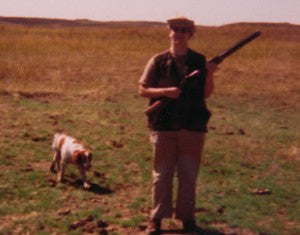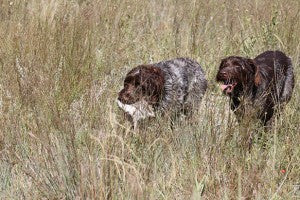Your Cart is Empty
Electronic Collars
Collars and Leads
Dog Tracking Systems
Dog Training
Bird Launchers
Hunting Dog Supplies
For The Hunter
Postcards from the Great Plains: First Post
September 25, 2013 4 min read
I'm a real huntress, but you won't catch me modeling camo bikinis anytime soon as a mother of three and creeping up on forty faster than an unbroken dog on pen-raised quail. But I have a passion for versatile hunting with versatile dogs.
I was lucky enough to have been raised in Pheasants Forever's #5 Best Bird Hunting Town in America for 2013: Valentine, Nebraska http://www.pheasantblog.org/the-25-best-bird-hunting-towns-in-america/. Too busy playing volleyball and basketball back then to worry about trudging around the sand dunes looking for birds, the hunting bug didn't bite me until around 2001, following the birth of my first child. I'm pretty sure that I was just tired of being left at home while the husband went hunting.

Out hunting for the first time with our first bird dog, Sheaf, an AKC Brittany.

I was very proud of my first grouse back in 2001.
The Nebraska Sandhills is a rugged area that was settled by Europeans in the early to mid-1800s, and it wasn't long after that market hunters pursued sharp-tailed grouse and prairie chickens with abandon for East Coast dinner tables. Even after management practices were put into place, liberal daily bag limits lasted all the way into the 1950s. Today, the Greater Prairie Chicken struggles to maintain its last stronghold amidst the cattle ranches, but the sharp-tailed grouse is still going strong, with more birds dying from old age every year than from hunting. (Farrar, 2011)

A Nebraska market hunter, his dogs, and a load of prairie chickens.
Hunting the Sandhills in late summer requires light clothing, excellent fitting boots, and specialized gear available from Lion Country Supply. While my husband's hunting boots are custom made, mine are off the shelf, so I find myself wearing wool socks even in the heat to avoid blisters on my feet . The best type of hunting vest to wear to keep cool is a strap vest because it allows the upper core of your chest and shoulders to ventilate. Have a leather man tool or hemostat on hand for pulling porcupine quills and cactus spines from the dogs. Newcomers will find a GPS handheld absolutely essential to find your way back to your truck, but after a decade of hunting the area, I've gotten pretty good at navigating and only get turned around enough to keep it exciting. As with any hunt, carrying water is mandatory and water breaks are needed for man and dog every 30-45 minutes, which I found out the hard way a few years back when I nearly passed out from dehydration. Last but not least, good shotgun shells are a must when every shot counts and Fiocchi Golden Pheasant is the best lead shot there is. In our 12-gauges we use improved and modified chokes with 6 shot in lead for when we are hunting grouse only, but if we are working a mixed bag of ducks and grouse we go with steel 3 or 2 shot.
Although I've never hunted chukars in the high desert, I hear from friends that it is a very physically demanding hunt that requires a high level of fitness, similar to hunting sharp-tailed grouse in the Nebraska Sandhills. This isn't a South Dakota pheasant hunt; it can take hours to find your first bird and it is hard hiking. You will be challenged to find cellular service in most of the area, so going down with a heart attack is not an option there unless you are anxious to have a chat with St. Peter.
Grouse are high in the dunes where you find them. This year's Labor Day opener had my husband, Charles, and I hunting 100-300 yards apart. He saw 15-20 birds and got his limit in an hour and I walked the same amount of time and saw one single bird. The next day we walked for four hours in a place where we've always taken birds and didn't see anything. But the Sandhills are 20,000 square miles, so the birds have plenty of space to move about.

Sam, an AKC Wirehaired Pointing Griffon, and my husband Charles on the hunt.
Prairie chickens tend to like lower dunes and flatter valley areas. When one flushes, you won't know it any different than a grouse until you stop and take a closer look. Here is a side by side photograph from 2011 where I took this lovely rooster prairie chicken (top) and Charles harvested a big male sharpie (bottom). Notice the differences on their chests and bellies.

Male Prairie Chicken at the top, Male Sharp-tailed Grouse on the bottom
The most important skill your dogs are going to bring to the dunes is retrieving, as scenting conditions are pretty poor with the stiff winds and dry air. Always be aware and ready to swing your shotgun, especially when your dog starts to act birdy. Be listening for the birds? wingbeats and their flight vocalization that sounds like a rapid "aw-gaw-gaw-gaw-gaw?.

Sam retrieves a grouse with Sue backing him up, both are griffons.
A little public service announcement from my rancher friends: even when hunting public range, the same rules apply as they do everywhere else; if a gate is open when you get there, leave it open; if is closed when you get there, close it back up once you pass through. You will most likely have to deal with cattle when hunting sharp-tailed grouse and prairie chickens, as the stock tanks beneath the windmills are going to be the primary source of water for your dogs. Try not to stress the cattle or let your dogs get too close because cows with calves will try to stomp on your dogs.
Most importantly, be in awe of the splendor and vastness of the Sandhills. Listen to what it whispers in the wind. Check out what passes beneath your feet: rosehips, homesteader grasshoppers, yuccas and lizards. Enjoy the time with your friends and dogs.
-Charity Upchurch, LCS Copy Writer

Sharpies all around for myself, our friend Ryan Tompkins and Charles, with griffons Sue, Sam and BB.

Me and my prairie chicken, Ryan and Charles with sharpies, griffons BB, Sue and Sam.

Another day of sharpies with Ryan, Charles and I, with griffons Mae, Sam and Sue.

Sharpies for me, and a mixed bag for the guys all retrieved by griffon Sam.
Leave a comment
Comments will be approved before showing up.
Subscribe
Sign up to get the latest on sales, new releases and more …
Featured Products

Subscribe
Sign up to get the latest on sales, new releases and more …



